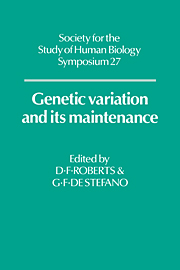Book contents
- Frontmatter
- Contents
- Preface
- Part I Genetic Diversity - Its Dimensions
- Genetic polymorphisms - a widening panorama
- Some implications of improved electrophoresis techniques for population genetics
- HLA variation in the tropics
- Chromosome polymorphism in humans
- Restriction fragment length polymorphisms in the human genome
- Nucleotide sequences, restriction maps, and human mitochondrial DNA diversity
- Mitochondrial DNA variation in eastern highlanders of Papua New Guinea
- The Contribution of polymorphisms in mtDNA to population genetic studies
- Part II Genetic Diversity - Its Origin and Maintenance
- GENETIC DIVERSITY - APPLICATIONS AND PROBLEMS OF COMPLEX CHARACTERS
- Index
HLA variation in the tropics
Published online by Cambridge University Press: 05 March 2012
- Frontmatter
- Contents
- Preface
- Part I Genetic Diversity - Its Dimensions
- Genetic polymorphisms - a widening panorama
- Some implications of improved electrophoresis techniques for population genetics
- HLA variation in the tropics
- Chromosome polymorphism in humans
- Restriction fragment length polymorphisms in the human genome
- Nucleotide sequences, restriction maps, and human mitochondrial DNA diversity
- Mitochondrial DNA variation in eastern highlanders of Papua New Guinea
- The Contribution of polymorphisms in mtDNA to population genetic studies
- Part II Genetic Diversity - Its Origin and Maintenance
- GENETIC DIVERSITY - APPLICATIONS AND PROBLEMS OF COMPLEX CHARACTERS
- Index
Summary
INTRODUCTION
The HLA system consists of over 100 antigens in six segregant series. Kissmeyer-Nielsen (1968) first identified two closely linked loci, with genes controlling two independent series of antigens, the A and B series, while Sandberg et al (1970) proposed a third locus (C). These are situated close together on chromosome 6 (Fig. 1), but their independence was confirmed by the cross-overs that occur between them (Kissmeyer-Nielsen et al, 1969; Low et al, 1974). Whereas antigens at these loci are recognised by serological methods, the fourth locus (D) was recognised from examination of mixed lymphocyte reactions. When lymphocytes from two individuals are mixed together in appropriate culture conditions, the one stimulates the other to blastoid transformation and proliferation. The extent of the reaction depends upon the degree of histocompatibility between the individuals, and is largely dependent on the D locus. Serological correlates of the MLR were therefore sought, and following the detection on leukaemic cells of B cell alloantigens (Walford et al, 1975), a series of DR (= D-related) antisera were standardised. Extremely close to the DR locus is one controlling a second series (DQ) of antigens (Duquesnoy et al, 1979; De Kretser et al, 1983), while a further locus (DP) governing reactivity in the primed lymphocyte test (secondary MLC) is shown by both cellular and serological techniques (Shaw et al, 1980, 1982; Mawas et al, 1980). The relationship between the specificities defined by MLC and the DR, DP and DQ antigens remains unresolved.
Antigens of the A, B and C series are known as class 1 antigens, and are found on the cells of most body tissues.
- Type
- Chapter
- Information
- Genetic Variation and its Maintenance , pp. 29 - 38Publisher: Cambridge University PressPrint publication year: 1986
- 1
- Cited by



